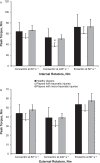Preseason Strength Assessment of the Rotator Muscles and Shoulder Injury in Handball Players
- PMID: 29341794
- PMCID: PMC5848241
- DOI: 10.4085/1062-6050-216-16
Preseason Strength Assessment of the Rotator Muscles and Shoulder Injury in Handball Players
Abstract
Context: Few researchers have identified intrinsic risk factors for shoulder injury in team handball players by analyzing measurements of maximal isokinetic rotator muscle strength.
Objective: To identify possible intrinsic risk factors for shoulder injury by analyzing measurements of maximal isokinetic rotator muscle strength.
Design: Cross-sectional study.
Setting: Male team handball senior divisions (the highest level) in France and Belgium.
Patients or other participants: A total of 108 male high-level handball players (age = 24 ± 4 years, height = 189 ± 6 cm, mass = 87 ± 11 kg) were enrolled.
Main outcome measure(s): All players completed a preseason questionnaire and performed a bilateral isokinetic assessment of the shoulder rotator muscles. On a monthly questionnaire, players reported any shoulder injury that they sustained during the season.
Results: On the preseason questionnaire, 51 of 108 (47%) participants reported a history of dominant-shoulder injury. A total of 106 participants completed the in-season questionnaire, with 22% (n = 23) reporting a shoulder injury on their dominant side during the subsequent season. Fourteen percent (n = 15) sustained microtraumatic injuries, and 8% (n = 8) described a traumatic injury. Backcourt players had a 3.5-times increased risk of injury during the new season compared with players in other positions. Among the isokinetic results, no risk factor for further injury was identified in handball players with microtraumatic injuries. For traumatic injuries, the concentric maximal strength developed by the internal rotators at high speed (240°/s) in the dominant shoulder was a protective factor against the risk of further injury.
Conclusions: These results can potentially identify intrinsic risk factors for shoulder injury and may be used to determine potential interventions for reducing this risk in handball players.
Keywords: isokinetic strength; prospective study; risk factors; rotator cuff weakness.
Figures


References
-
- Langevoort G, Myklebust G, Dvorak J, Junge A. . Handball injuries during major international tournaments. Scand J Med Sci Sports. 2007; 17 4: 400– 407. - PubMed
-
- Vlak T, Pivalica D. . Handball: the beauty or the beast. Croat Med J. 2004; 45 5: 526– 530. - PubMed
-
- Myklebust G, Hasslan L, Bahr R, Steffen K. . High prevalence of shoulder pain among elite Norwegian female handball players. Scand J Med Sci Sports. 2013; 23 3: 288– 294. - PubMed
-
- Reckling C, Zantop T, Petersen W. . Epidemiology of injuries in juvenile handball players [in German]. Sportverl Sportschad. 2003; 17 3: 112– 117. - PubMed
-
- Seil R, Rupp S, Tempelhof S, Kohn D. . Sports injuries in team handball: a one-year prospective study of sixteen men's senior teams of a superior nonprofessional level. Am J Sports Med. 1998; 26 5: 681– 687. - PubMed
MeSH terms
LinkOut - more resources
Full Text Sources
Other Literature Sources
Medical

